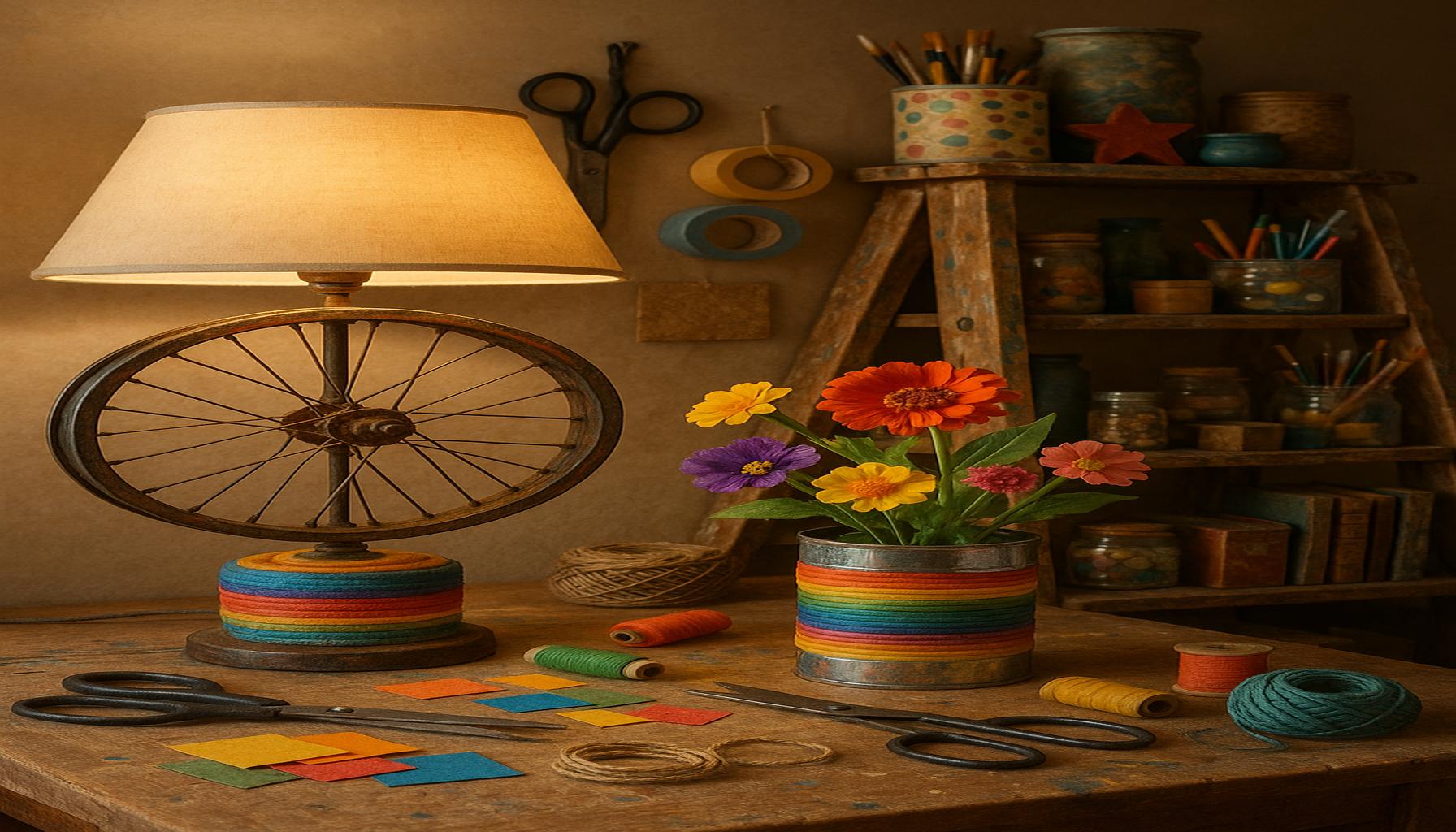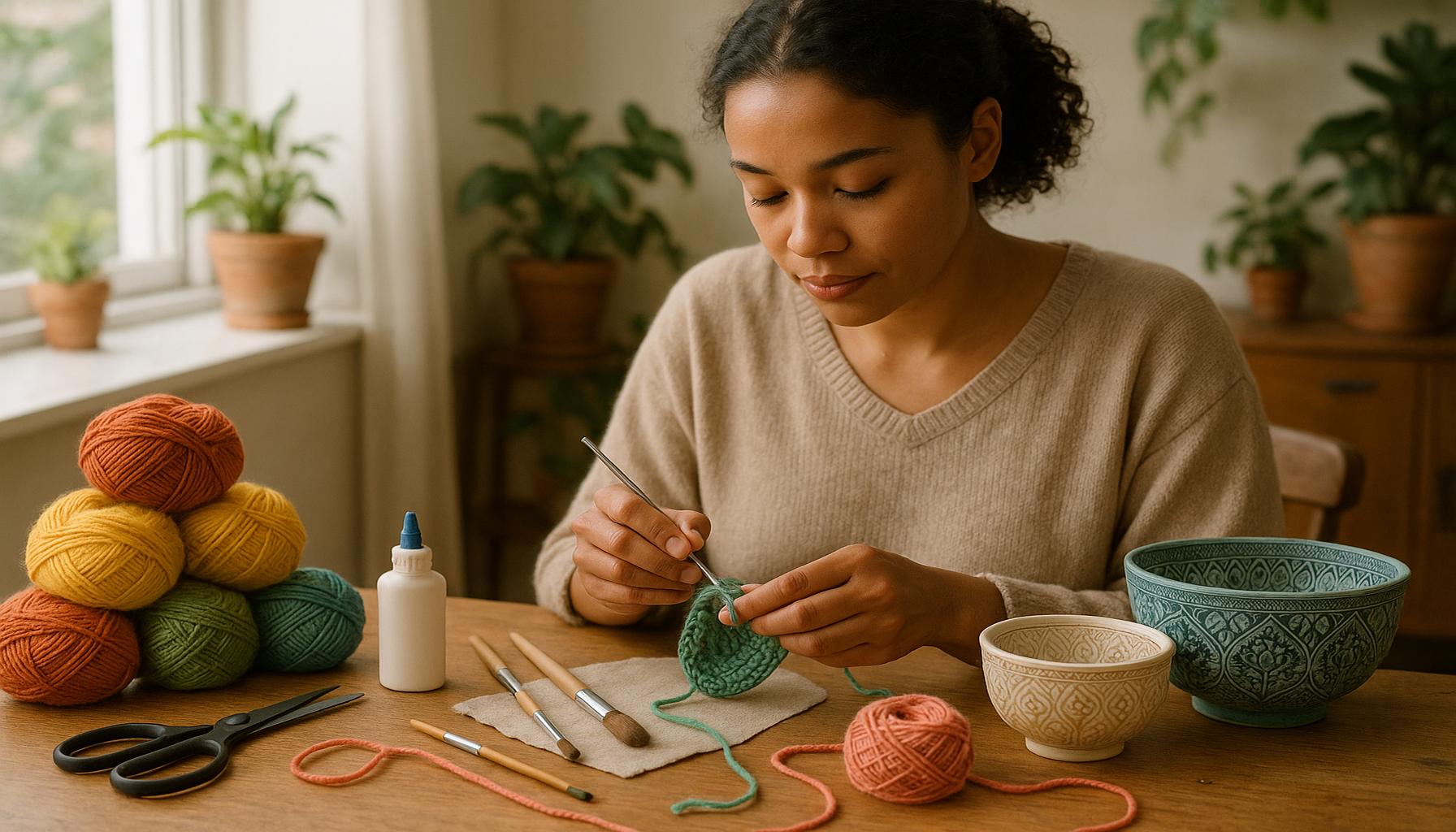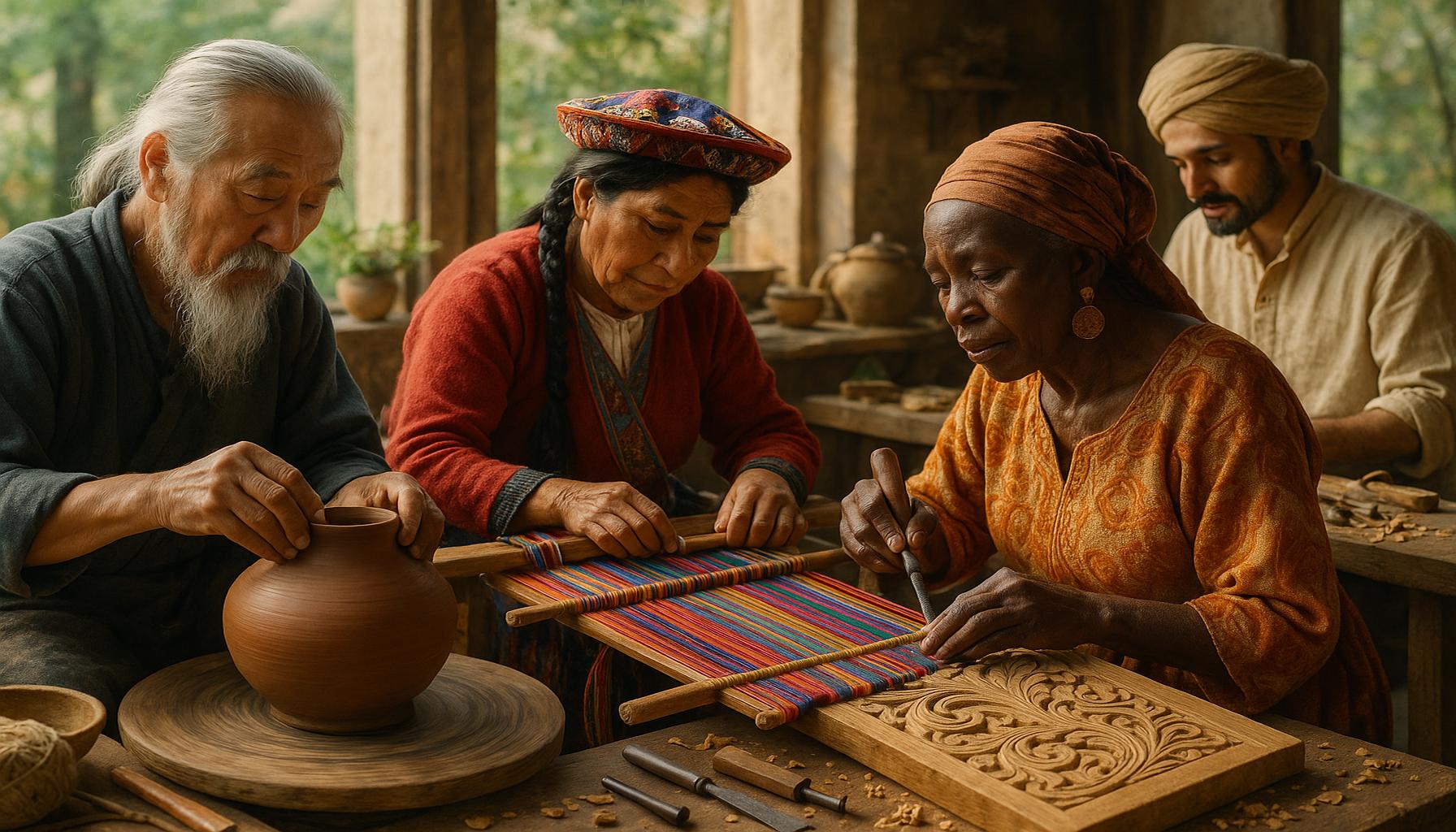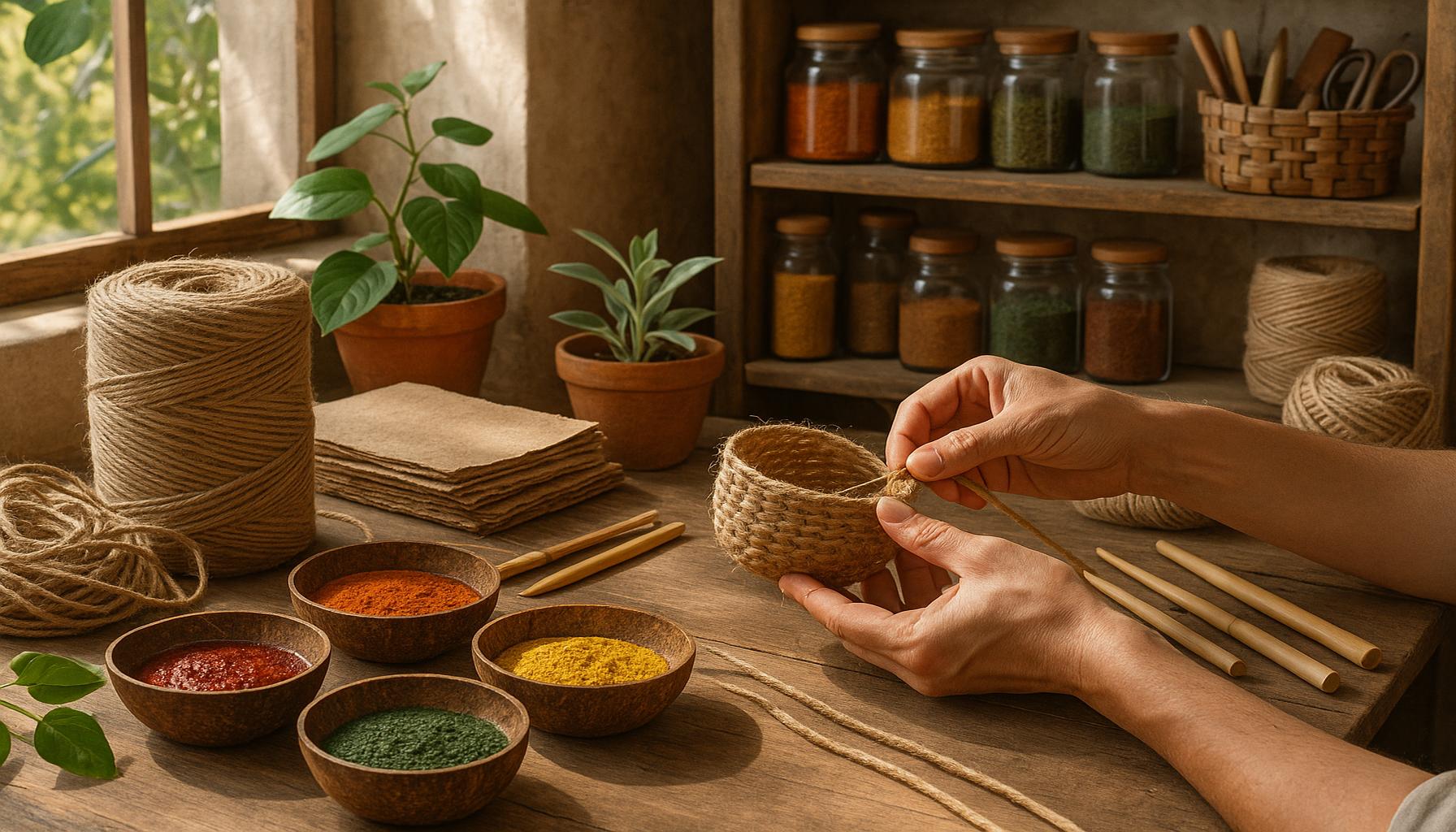Upcycled Crafting: Transforming Everyday Items into Unique Art Pieces

Exploring the World of Upcycled Crafting
In recent years, the practice of upcycled crafting has gained significant momentum, captivating the hearts and minds of environmentally conscious creators across the United States. This innovative art form encourages individuals to embrace sustainability by transforming everyday items that would typically be discarded into breathtaking artworks. Whether it’s a shattered mirror, an old pair of jeans, or leftover kitchen containers, the possibilities for upcycling are virtually endless.
Innovative Applications of Upcycling
One popular avenue of upcycled crafting is through repurposed furniture. Imagine taking a broken chair that has seen better days and giving it a new lease on life as a stylish plant stand. A coat of vibrant paint, some creative stenciling, and new hardware can turn an outdated piece into a centerpiece for any room.
Jewelry from junk is another rewarding aspect of upcycled crafting that has garnered attention. By using old buttons, scraps of fabric, or even discarded electronic wires, artisans create unique accessories that tell a story. For instance, a necklace fashioned from vintage buttons can serve not only as a fashionable statement piece but also as a conversation starter, highlighting the beauty found in the old and forgotten.
Furthermore, home décor projects often utilize recycled materials to produce captivating wall art. From creating collages with torn pages of old books to weaving colorful tapestries from fabric scraps, the impact of upcycled materials shines through in personal and spirited designs. Such items can become the focal point of a room, showcasing both creativity and commitment to sustainability.
The Driving Forces Behind Upcycled Crafting
Why has this movement garnered such popularity? The answers lie in a combination of motives:
- Environmental Impact: By reducing the amount of waste that ends up in landfills, crafters contribute to environmental conservation. It is estimated that upcycling can significantly lower pollution rates and decrease the demand for new raw materials.
- Cost-Effective Solutions: Upcycling encourages individuals to use materials they already possess, thereby keeping costs low. Crafting with items that would otherwise go to waste makes it an accessible hobby for people from various economic backgrounds.
- Personalized Creations: The beauty of upcycled crafting lies in its ability to produce one-of-a-kind pieces that reflect the unique personality and style of the creator. Customization becomes a key aspect of crafting, allowing individuals to express themselves in ways commercially produced items cannot.
By intertwining creativity with environmental stewardship, upcycled crafting not only transforms discarded items into art but also fosters a sense of community. As more individuals embrace this innovative approach, they become part of a larger movement aimed at reducing waste while promoting artistic expression. Dive into the world of upcycled crafting and explore endless possibilities for turning the ordinary into the extraordinary while making a positive impact on our planet.
DIVE DEEPER: Click here to discover more</a
Creative Techniques in Upcycled Crafting
As the movement of upcycled crafting continues to flourish, innovative techniques are emerging that allow creators to push the boundaries of their artistic expression. These methods not only breathe new life into discarded items but also offer inspiration for those looking to embark on their own upcycling journey. Here, we explore several captivating techniques that bring upcycled artistry to the forefront.
Fabric Manipulation and Textile Reconstruction
One of the most accessible forms of upcycling involves fabric manipulation. Crafters can transform worn-out clothing or leftover fabric scraps into vibrant pieces. This may include:
- Patching: Instead of throwing away a pair of jeans with a hole, consider patching it with another scrap of fabric or an embroidery technique. Not only does this provide functionality, but it adds a unique flair to your wardrobe.
- Quilting: Old shirts, skirts, or linens can be sewn together to create cozy quilts, each piece telling a story of its past life. This allows for extensive creativity, experimenting with colors, textures, and designs.
- Fabric Flowers: Upcycling fabric into stylish flowers for home décor or hair accessories is another popular method. Simple cuts and folds can transform mundane materials into beautiful blooms that elevate everyday items.
Artistic Recycling of Household Items
Exploring the potential of common household items opens an exciting pathway for creating art. Typical waste materials can be easily transformed into functional or decorative pieces. Consider these popular examples:
- Bottle Cap Art: These colorful bits often end up in landfills, but they can be arranged into mesmerizing mosaics or unique wall art. By hot gluing them onto canvas or wood, crafters can create stunning visuals that bring a pop of color to any space.
- Glass Jar Lanterns: Empty glass jars can be converted into enchanting lanterns or candle holders. By adding paint, twine, or other embellishments, these pieces can illuminate your home while showcasing a personal touch.
- Old Books as Décor: Instead of discarding tattered books, artists can repurpose them into decorative items such as book page wreaths or sculptures. This not only highlights creativity but also celebrates the written word.
The Tools of the Trade
For those interested in upcycled crafting, acquiring the right tools can enhance the experience and outcome. Some essential tools include:
- Basic sewing kit: A good set of needles, threads, and scissors is crucial for fabric manipulation, while additional items like embroidery floss can elevate creativity.
- Hot glue gun: Ideal for quickly attaching various materials, a hot glue gun is a staple for all upcyclers, whether crafting with fabric, paper, or plastic.
- Crafting mats and workspaces: Designate a space in your home to allow for both spontaneous inspiration and organized project assembly, ensuring a welcoming atmosphere for your artistic endeavors.
These creative techniques in upcycled crafting not only stimulate the imagination but also inspire individuals to view waste through a different lens. By redirecting their focus towards repurposing, artists unlock a treasure trove of potential lurking in everyday items. The end results are often remarkable, turning the ordinary into extraordinary art pieces that tell the story of their transformation.
| Category | Description |
|---|---|
| Environmental Benefits | Upcycling reduces waste by giving new life to items that would normally be discarded, contributing to a sustainable lifestyle. |
| Creative Expression | This craft allows artists to explore individual creativity while transforming ordinary items into stunning art pieces. |
Upcycled crafting serves as a resourceful avenue for individuals to unleash their creativity while simultaneously addressing pressing environmental concerns. By turning everyday items into unique art pieces, crafters and artists engage in a practice that not only transforms objects, but also narratives surrounding wastefulness and consumer culture. For example, old glass jars can be transformed into beautiful lanterns, while denim scraps can turn into trendy wall hangings. This practice encourages makers to think outside the box about materials that they often overlook, ultimately reshaping their perspective on consumption. Furthermore, workshops centered on upcycled crafting are increasing in popularity, drawing communities together and fostering collaboration among artists and DIY enthusiasts. As individuals delve deeper into upcycling techniques, they discover new approaches to art that are not only visually captivating but also imbued with personal stories and meanings, enhancing their connection to the environment and creativity alike.
DIVE DEEPER: Click here to discover the secrets of artisan bread
Exploring Upcycled Art Forms
As the quest for sustainable living gains traction, upcycled crafting is becoming a vibrant form of artistic expression that transcends mere aesthetics. Artists and crafters alike are increasingly showcasing their talents through various inventive mediums. These art forms delve deeper than decoration—they emphasize sustainability and creativity, resonating with a growing audience that appreciates the story behind every piece. Below, we delve into some captivating upcycled art forms that are shaping the landscape of creative reimagining.
Furniture Makeovers
One of the most dramatic transformations in upcycled crafting can be seen in furniture makeovers. By simply reimagining outdated or discarded pieces, crafters can create stunning functional art for their homes. Consider the following styles:
- Decoupage Furniture: Using vintage fabrics, wallpapers, or even newspaper clippings, crafters can apply decoupage techniques to breathe new life into old furniture. Items such as stools, tables, or cabinets can serve as unique conversation starters, adorned with images or quotes that resonate with the owner.
- Pallet Furniture: Wooden pallets, often considered waste, can be transformed into elegant and rustic furniture, including coffee tables, chairs, and even garden benches. With a little sanding and creativity, sturdy, stylish furniture pieces emerge as environmentally friendly alternatives.
- Upcycled Upholstery: Old couches and chairs can be revitalized by reupholstering with thrifted or repurposed fabrics. This technique allows for endless combinations of color and texture, providing individuality and charm to any living space.
Jewelry Making with Upcycled Items
In the world of jewelry making, upcycled materials offer infinite possibilities for crafting unique wearables. Fashion enthusiasts can convert a variety of everyday items into stunning accessories:
- Button Jewelry: Tattered clothing often yields a treasure trove of buttons. Crafters can create necklaces, bracelets, and earrings, each piece a testament to the stories behind the buttons’ origins and the garments they came from.
- Wire and Metal Art: Old electronics, such as headphones or wires, can be manipulated into striking jewelry pieces. This method not only trees waste but also showcases a modern, edgy aesthetic that can be both bold and minimalistic.
- Beaded Accessories: Broken jewelry or leftover beads can be reassembled to create one-of-a-kind necklaces and bracelets. Pairing these with rustic charms or found objects brings personal flair to every item.
Eco-Friendly Art Installations
Upcycled craft isn’t limited to home decor or personal accessories; it extends into the realm of public art. Many artists are using large-scale upcycled installations to convey powerful messages about sustainability:
- Community Murals: Artists are often hired to transform walls with elaborate murals that incorporate upcycled materials. These vibrant works serve not only to beautify a space but also to spark conversations about waste reduction and environmental awareness.
- Public Sculptures: By collecting discarded items such as metal scraps or plastic waste, local artists are crafting astonishing sculptures that draw communities together while highlighting the severity of the waste crisis.
- Interactive Installations: Some artists create interactive pieces using upcycled materials that encourage viewer participation, such as using throwaway items to craft a climbing structure that doubles as a commentary on consumer habits.
Ultimately, these explorations into upcycled art forms reveal a profound possibility of renewal. By transforming what once seemed unusable into cherished pieces, creators encourage a shift in perspective—one that values sustainability, creativity, and the stories that each object carries. Each unique creation reminds us of the beauty in embracing what we already possess while advocating for a greener future.
DISCOVER MORE: Click here to dive into sustainability trends
Conclusion: The Impact of Upcycled Crafting
As the world becomes increasingly aware of the environmental challenges we face, upcycled crafting emerges as a powerful response—one that not only fosters creativity but also promotes sustainability. The myriad of artistic transformations demonstrated through furniture makeovers, unique jewelry designs, and large-scale eco-friendly installations underscores the potential in embracing discarded items rather than contributing to waste. Each refurbished piece tells a story, giving a second life to materials that would otherwise likely end up in landfills.
Moreover, upcycled art serves as a visual dialogue about consumerism and the importance of mindful consumption. By encouraging individuals to rethink their relationship with everyday objects, artists and crafters inspire communities to appreciate the beauty in imperfection and the artistic possibilities of what already exists. This movement taps into a broader cultural shift towards sustainability, revealing how art can intersect with social consciousness in meaningful ways.
As you explore the world of upcycled crafting, consider the potential of your own everyday items. Whether you take on a DIY project at home or support artists in your community, you become part of this creative revolution. The next time you face a broken chair or a stack of old buttons, remember: these materials are not merely waste; they are opportunities waiting to be transformed into unique art pieces, each contributing to a greener future and enriched storytelling.


